Home / Table of Functional Group Priorities for Nomenclature
Alkanes and Nomenclature
Table of Functional Group Priorities for Nomenclature
Last updated: June 12th, 2025 |
How To Determine Which Functional Group Has “Priority” For Naming Purposes
- When a molecule has multiple functional groups, we could potentially run into problems when deciding on how to name it.
- For example, does a molecule that contains both a hydroxyl group (-OH) and a carboxylic acid (-COOH) get named as an alcohol (with suffix –ol ) or as a carboxylic acid (with suffix -acid) ?
- To resolve these questions, a priority sequence or hierarchy of functional groups has been established by the international chemistry community (IUPAC, the International Union of Pure and Applied Chemistry).
- The key rules are summarized in the article below!
Table of Contents
-
- A Nomenclature Dilemma
- Highest Priority Groups: Carboxylic Acids, Sulfonic Acids, Esters, Acid Halides, Amides
- Next In Line: Nitrile, Aldehyde, Ketone, Alcohol, Thiol, Amine
- Alkenes and Alkynes
- Alkenes vs. Alkynes: Which Takes “Priority”?
- Functional Groups That Are Always Prefixes: Halides, Alkoxides, Azides, Nitro
- Some Examples With Multiple Functional Groups
- Notes
- Quiz Yourself!
- (Advanced) References and Further Reading
1. A Nomenclature Dilemma
Here’s a little nomenclature dilemma.
Let’s say you’re trying to name a molecule. You’re familiar with the familiar naming suffixes like -ol, -ene, -ane, -oic acid and so on. But then you come across a molecule which has multiple functional groups.
What do you do? What suffix do you give the molecule?
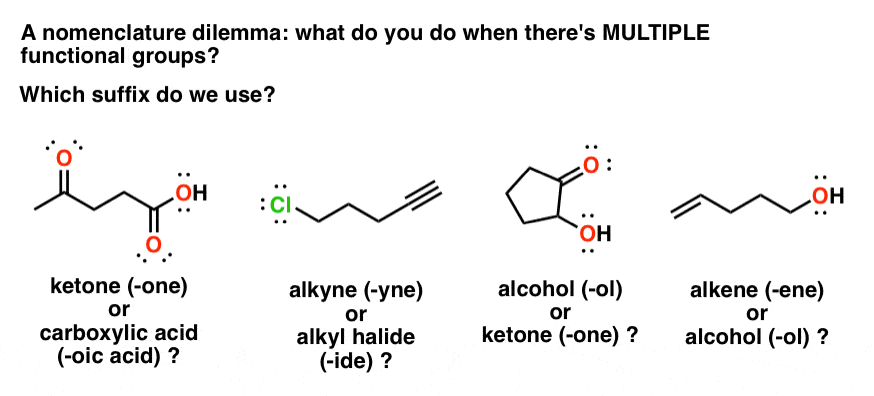
We need some kind of priority system for nomenclature. And so, IUPAC (think of the “Ministry of Magic”, but for chemists) has developed one. If you have a molecule with, say, a carboxylic acid and a ketone you consult the table.
The functional group with the highest priority will be the one which gives its suffix to the name of the molecule.
So in example #1 above, the suffix of the molecule will be “-oic acid” , not “-one”, because carboxylic acids are given higher priority. However, if a ketone is present with an alcohol (example 3) then we will use the suffix, “-one” because ketones have a higher priority for nomenclature than alcohols.
[You might ask: what is this based on? It’s an arbitrary agreement by IUPAC [source], although note that there is some correlation between the oxidation state of the carbon and the priority (more oxidized groups tend to be higher priority). However this really is an example of something you have to either look up , memorize, or have a computer do for you. It’s not conceptual. ] See Note 1.
2. Highest Priority Groups: Carboxylic Acids, Sulfonic Acids, Esters, Acid Halides, Amides
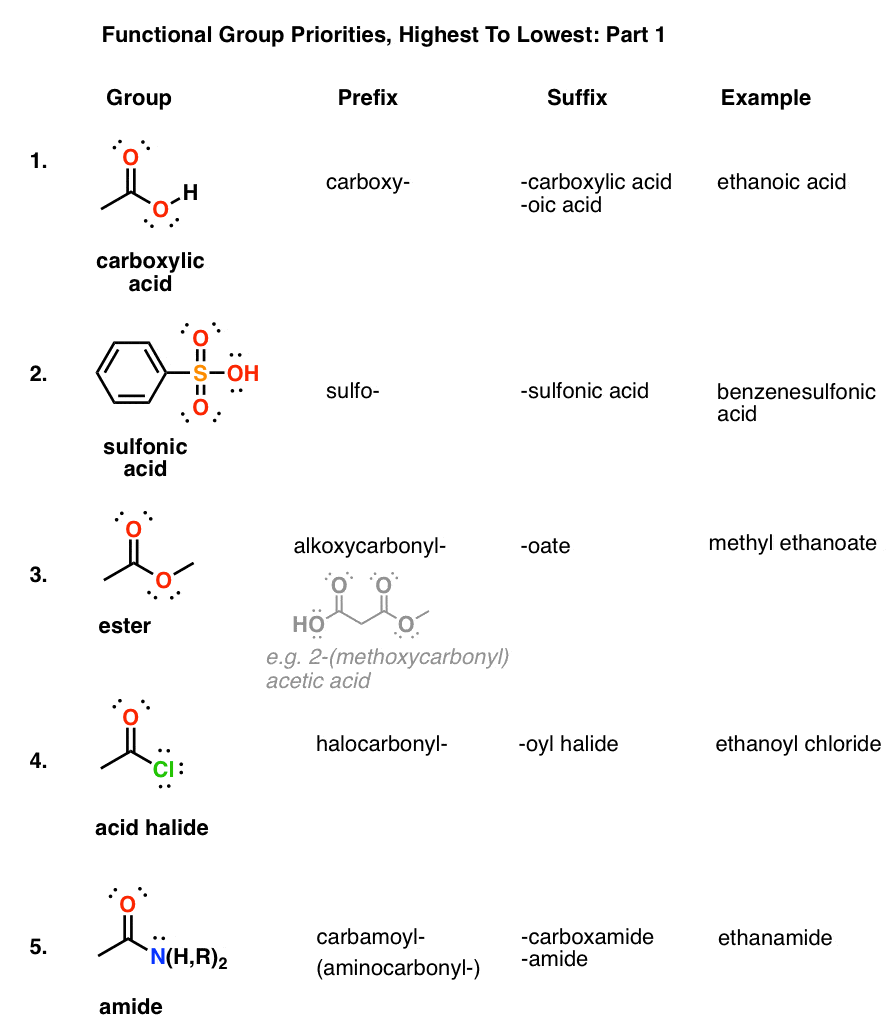
Note that with the exception of sulfonic acids, these are all carboxylic acid derivatives. IUPAC goes into way more detail than we need to here.
The “seniority rules” continue in the following order, where we are cherry-picking the most common examples. [Note 2]
3. Next In Line: Nitrile, Aldehyde, Ketone, Alcohol, Thiol, Amine
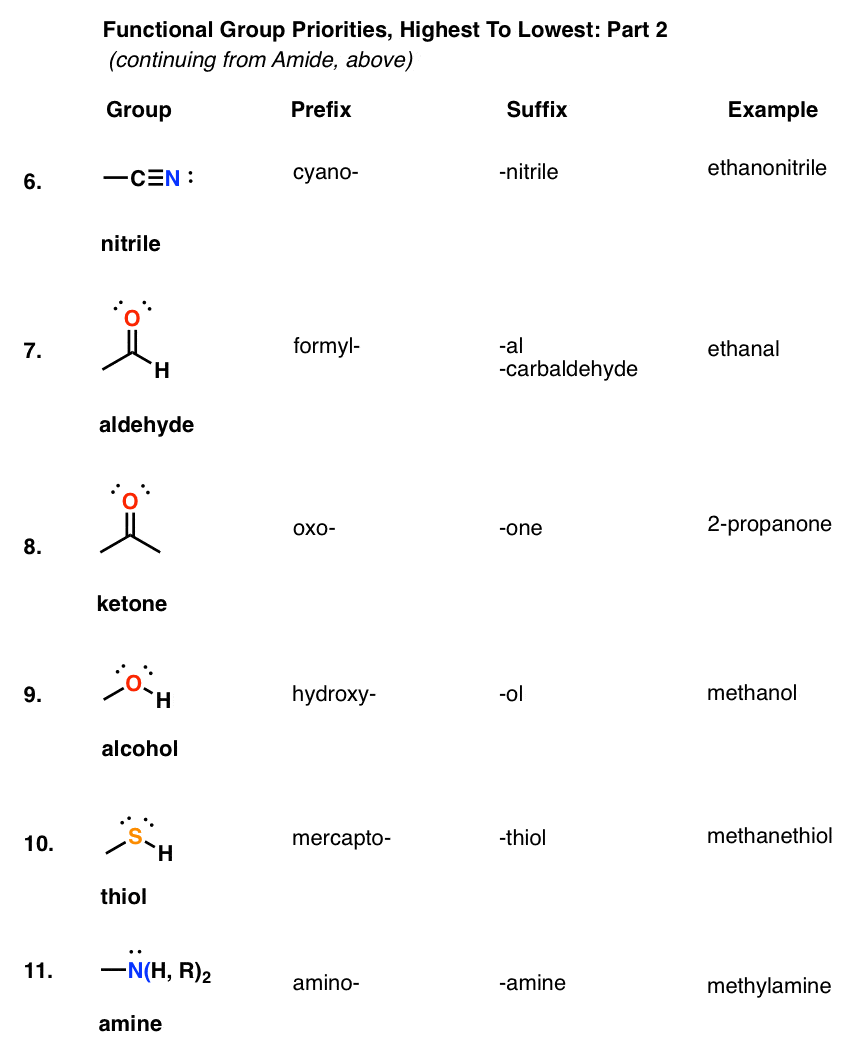
Again, this is not a complete list – we’re cherry picking the most commonly encountered functional groups here.
4. Alkenes And Alkynes
If carbon-carbon multiple bonds are present in the molecule, they are considered as substituents with a priority (or “seniority”, according to IUPAC) lower than that of amines.
So for a molecule with an alkene and an alcohol, the alcohol has priority and the molecule has the suffix, “-ol”. The presence of the double bond is noted with the locant followed by the prefix, “en-“. For example, pent-4-en-1-ol.
If no higher-priority groups are present, the suffix for a molecule containing an alkene will be “-ene”, such as in pent-1-ene.
For an alkyne, the corresponding prefix is “-yn” and the suffix is “yne”.
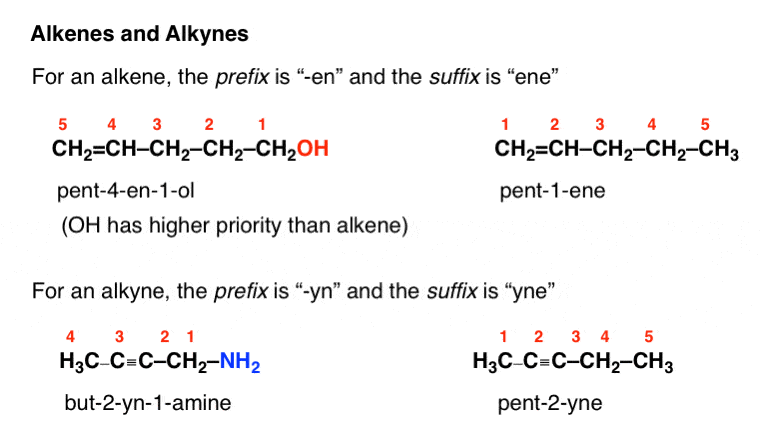
At this point the methodology for naming molecules changes slightly. In the absence of one of the above functional groups, the suffix will always be “-ane”, “-ene”, or “-yne”, depending on whether any unsaturation is present in the molecule, and any lower-ranked substituents will be prefixes.
5. Alkenes vs. Alkynes: Which Takes “Priority”?
This brings us to a common source of confusion in nomenclature. When an alkene and an alkyne are present in a molecule, which takes priority?
It depends on what you mean by “priority”.
For the purposes of the name, “-ene” comes before “-yne” alphabetically. So when an alkene and an alkyne are present in the same molecule, the ending will always be “yne”.
For the purposes of numbering, if there is a tie between an alkene and an alkyne for determining the lowest locant, the alkene takes priority.
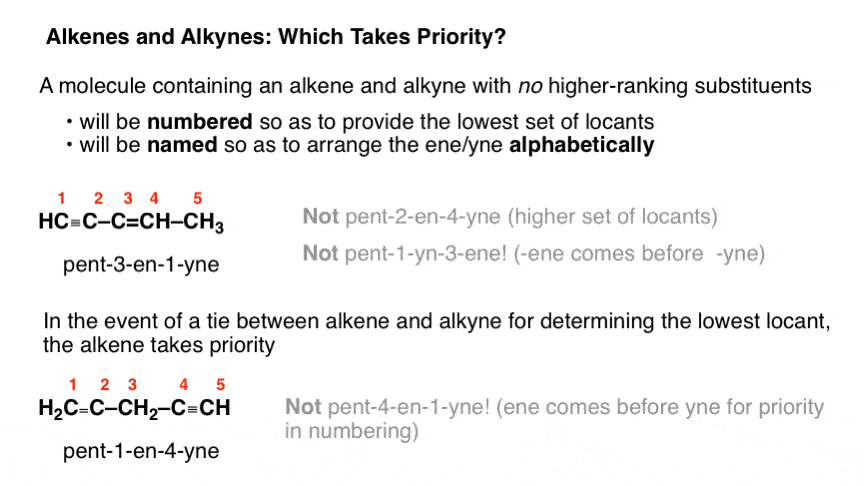
IUPAC says it this way:

Right. Let’s move along to the other functional groups. Sandwich
6. Functional Groups That Are Always Prefixes: Halides, Alkoxides, Azides, Nitro
Some functional groups have been deemed unworthy of ever getting their own suffixes. For nomenclature purposes, they are forever out of the limelight, subservient to the -ane, -ene, or -yne ending of the parent hydrocarbon (or “parent hydride”, as IUPAC calls it).
These groups include the halides (bromo, chloro, fluoro, iodo), ethers (“alkoxy”), azide and nitro functional groups. Source: Table 5.1, Section P-59.1.9 of the 2013 Blue Book (Page 630).
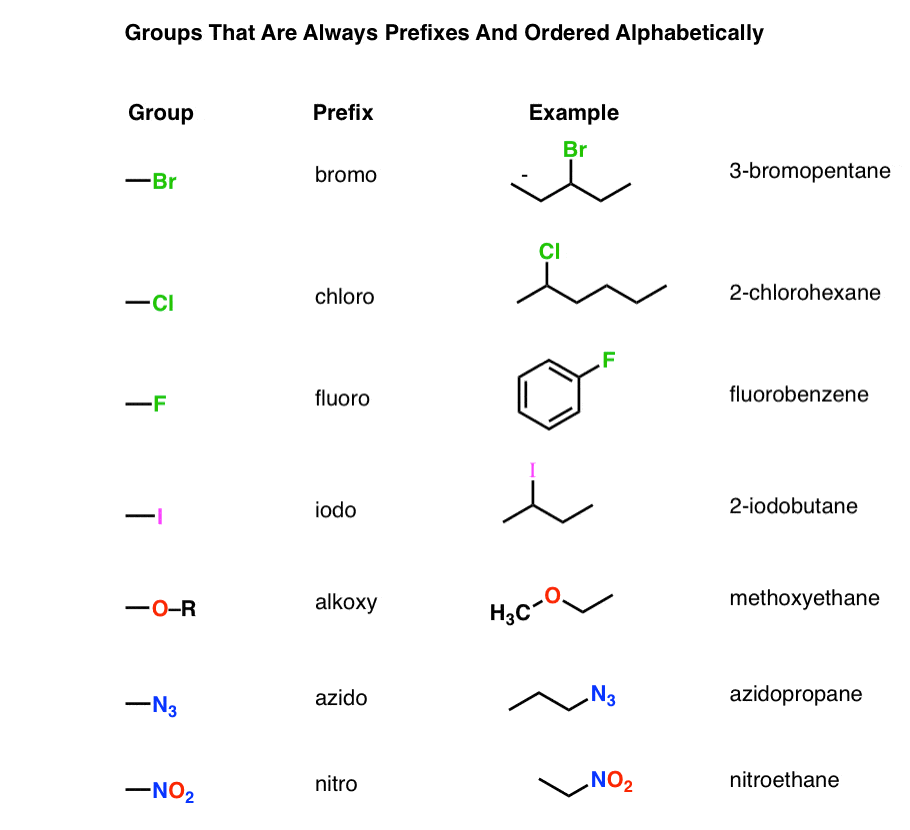
7. Some Examples With Multiple Functional Groups
Here are some examples of applying the order of functional group priorities to solve nomenclature problems. The highest ranked functional group becomes the suffix – it’s highlighted in red.
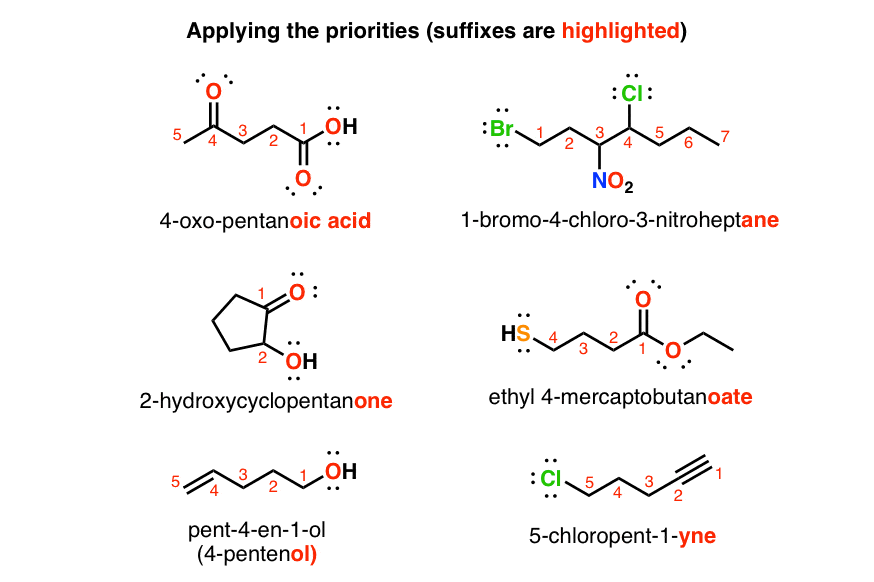
This covers most of the functional groups you’ll meet in Org1/Org2.
Notes
Related Articles
Note 1. This article takes into account the latest recommendations of the IUPAC Blue Book (2013 edition)]
Note 2. . Just for the record these “rules for seniority” can be found in section P-41 of the Blue Book, page 428 of the 2013 edition.
Quiz Yourself!

Become a MOC member to see the clickable quiz with answers on the back.
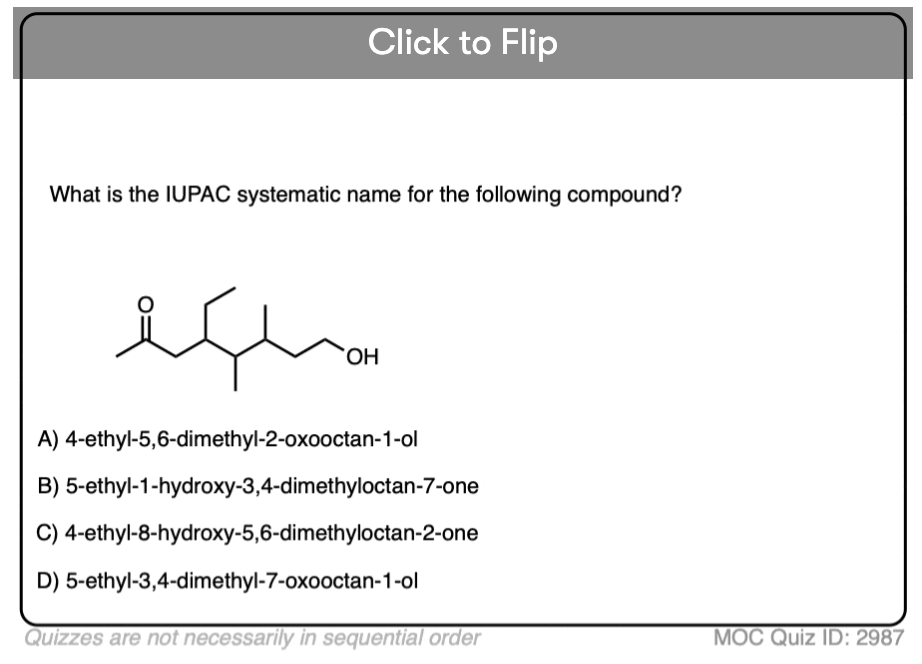
Become a MOC member to see the clickable quiz with answers on the back.

Become a MOC member to see the clickable quiz with answers on the back.
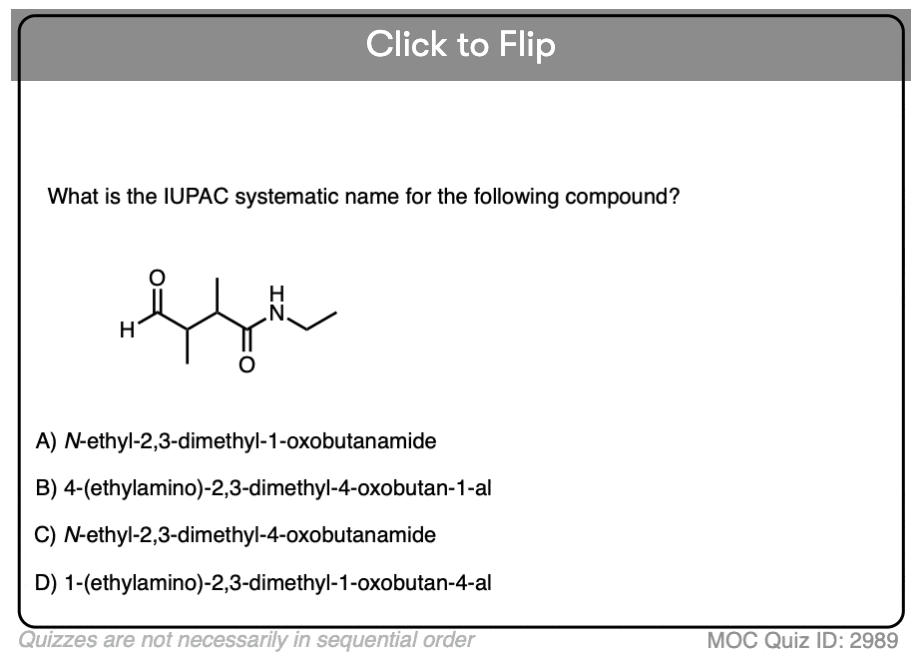
Become a MOC member to see the clickable quiz with answers on the back.

Become a MOC member to see the clickable quiz with answers on the back.
(Advanced) References and Further Reading
- IUPAC Blue Book. Nomenclature of Organic Chemistry – IUPAC Recommendations and Preferred Names 2013
Henri A. Favre; Warren H. Powell
DOI: doi.org/10.1039/9781849733069
This book contains IUPAC’s preferred names for organic compounds, which is not to say that all chemists follow their recommendations unanimously.
Section P-41, page 428 contains the rules for “seniority”.
00 General Chemistry Review
01 Bonding, Structure, and Resonance
- How Do We Know Methane (CH4) Is Tetrahedral?
- Hybrid Orbitals and Hybridization
- How To Determine Hybridization: A Shortcut
- Orbital Hybridization And Bond Strengths
- Sigma bonds come in six varieties: Pi bonds come in one
- A Key Skill: How to Calculate Formal Charge
- The Four Intermolecular Forces and How They Affect Boiling Points
- 3 Trends That Affect Boiling Points
- How To Use Electronegativity To Determine Electron Density (and why NOT to trust formal charge)
- Introduction to Resonance
- How To Use Curved Arrows To Interchange Resonance Forms
- Evaluating Resonance Forms (1) - The Rule of Least Charges
- How To Find The Best Resonance Structure By Applying Electronegativity
- Evaluating Resonance Structures With Negative Charges
- Evaluating Resonance Structures With Positive Charge
- Exploring Resonance: Pi-Donation
- Exploring Resonance: Pi-acceptors
- In Summary: Evaluating Resonance Structures
- Drawing Resonance Structures: 3 Common Mistakes To Avoid
- How to apply electronegativity and resonance to understand reactivity
- Bond Hybridization Practice
- Structure and Bonding Practice Quizzes
- Resonance Structures Practice
02 Acid Base Reactions
- Introduction to Acid-Base Reactions
- Acid Base Reactions In Organic Chemistry
- The Stronger The Acid, The Weaker The Conjugate Base
- Walkthrough of Acid-Base Reactions (3) - Acidity Trends
- Five Key Factors That Influence Acidity
- Acid-Base Reactions: Introducing Ka and pKa
- How to Use a pKa Table
- The pKa Table Is Your Friend
- A Handy Rule of Thumb for Acid-Base Reactions
- Acid Base Reactions Are Fast
- pKa Values Span 60 Orders Of Magnitude
- How Protonation and Deprotonation Affect Reactivity
- Acid Base Practice Problems
03 Alkanes and Nomenclature
- Meet the (Most Important) Functional Groups
- Condensed Formulas: Deciphering What the Brackets Mean
- Hidden Hydrogens, Hidden Lone Pairs, Hidden Counterions
- Don't Be Futyl, Learn The Butyls
- Primary, Secondary, Tertiary, Quaternary In Organic Chemistry
- Branching, and Its Affect On Melting and Boiling Points
- The Many, Many Ways of Drawing Butane
- Wedge And Dash Convention For Tetrahedral Carbon
- Common Mistakes in Organic Chemistry: Pentavalent Carbon
- Table of Functional Group Priorities for Nomenclature
- Summary Sheet - Alkane Nomenclature
- Organic Chemistry IUPAC Nomenclature Demystified With A Simple Puzzle Piece Approach
- Boiling Point Quizzes
- Organic Chemistry Nomenclature Quizzes
04 Conformations and Cycloalkanes
- Staggered vs Eclipsed Conformations of Ethane
- Conformational Isomers of Propane
- Newman Projection of Butane (and Gauche Conformation)
- Introduction to Cycloalkanes
- Geometric Isomers In Small Rings: Cis And Trans Cycloalkanes
- Calculation of Ring Strain In Cycloalkanes
- Cycloalkanes - Ring Strain In Cyclopropane And Cyclobutane
- Cyclohexane Conformations
- Cyclohexane Chair Conformation: An Aerial Tour
- How To Draw The Cyclohexane Chair Conformation
- The Cyclohexane Chair Flip
- The Cyclohexane Chair Flip - Energy Diagram
- Substituted Cyclohexanes - Axial vs Equatorial
- Ranking The Bulkiness Of Substituents On Cyclohexanes: "A-Values"
- Cyclohexane Chair Conformation Stability: Which One Is Lower Energy?
- Fused Rings - Cis-Decalin and Trans-Decalin
- Naming Bicyclic Compounds - Fused, Bridged, and Spiro
- Bredt's Rule (And Summary of Cycloalkanes)
- Newman Projection Practice
- Cycloalkanes Practice Problems
05 A Primer On Organic Reactions
- The Most Important Question To Ask When Learning a New Reaction
- Curved Arrows (for reactions)
- Nucleophiles and Electrophiles
- The Three Classes of Nucleophiles
- Nucleophilicity vs. Basicity
- What Makes A Good Nucleophile?
- What Makes A Good Leaving Group?
- 3 Factors That Stabilize Carbocations
- Equilibrium and Energy Relationships
- 7 Factors that stabilize negative charge in organic chemistry
- 7 Factors That Stabilize Positive Charge in Organic Chemistry
- What's a Transition State?
- Hammond's Postulate
- Learning Organic Chemistry Reactions: A Checklist (PDF)
- Introduction to Oxidative Cleavage Reactions
06 Free Radical Reactions
- Free Radical Reactions
- 3 Factors That Stabilize Free Radicals
- Bond Strengths And Radical Stability
- Free Radical Initiation: Why Is "Light" Or "Heat" Required?
- Initiation, Propagation, Termination
- Monochlorination Products Of Propane, Pentane, And Other Alkanes
- Selectivity In Free Radical Reactions
- Selectivity in Free Radical Reactions: Bromination vs. Chlorination
- Halogenation At Tiffany's
- Allylic Bromination
- Bonus Topic: Allylic Rearrangements
- In Summary: Free Radicals
- Synthesis (2) - Reactions of Alkanes
- Free Radicals Practice Quizzes
07 Stereochemistry and Chirality
- Types of Isomers: Constitutional Isomers, Stereoisomers, Enantiomers, and Diastereomers
- How To Draw The Enantiomer Of A Chiral Molecule
- How To Draw A Bond Rotation
- Introduction to Assigning (R) and (S): The Cahn-Ingold-Prelog Rules
- Assigning Cahn-Ingold-Prelog (CIP) Priorities (2) - The Method of Dots
- Enantiomers vs Diastereomers vs The Same? Two Methods For Solving Problems
- Assigning R/S To Newman Projections (And Converting Newman To Line Diagrams)
- How To Determine R and S Configurations On A Fischer Projection
- The Meso Trap
- Optical Rotation, Optical Activity, and Specific Rotation
- Optical Purity and Enantiomeric Excess
- What's a Racemic Mixture?
- Chiral Allenes And Chiral Axes
- Stereochemistry Practice Problems and Quizzes
08 Substitution Reactions
- Nucleophilic Substitution Reactions - Introduction
- Two Types of Nucleophilic Substitution Reactions
- The SN2 Mechanism
- Why the SN2 Reaction Is Powerful
- The SN1 Mechanism
- The Conjugate Acid Is A Better Leaving Group
- Comparing the SN1 and SN2 Reactions
- Polar Protic? Polar Aprotic? Nonpolar? All About Solvents
- Steric Hindrance is Like a Fat Goalie
- Common Blind Spot: Intramolecular Reactions
- Substitution Practice - SN1
- Substitution Practice - SN2
09 Elimination Reactions
- Elimination Reactions (1): Introduction And The Key Pattern
- Elimination Reactions (2): The Zaitsev Rule
- Elimination Reactions Are Favored By Heat
- Two Elimination Reaction Patterns
- The E1 Reaction
- The E2 Mechanism
- E1 vs E2: Comparing the E1 and E2 Reactions
- Antiperiplanar Relationships: The E2 Reaction and Cyclohexane Rings
- Bulky Bases in Elimination Reactions
- Comparing the E1 vs SN1 Reactions
- Elimination (E1) Reactions With Rearrangements
- E1cB - Elimination (Unimolecular) Conjugate Base
- Elimination (E1) Practice Problems And Solutions
- Elimination (E2) Practice Problems and Solutions
10 Rearrangements
11 SN1/SN2/E1/E2 Decision
- Identifying Where Substitution and Elimination Reactions Happen
- Deciding SN1/SN2/E1/E2 (1) - The Substrate
- Deciding SN1/SN2/E1/E2 (2) - The Nucleophile/Base
- SN1 vs E1 and SN2 vs E2 : The Temperature
- Deciding SN1/SN2/E1/E2 - The Solvent
- Wrapup: The Key Factors For Determining SN1/SN2/E1/E2
- Alkyl Halide Reaction Map And Summary
- SN1 SN2 E1 E2 Practice Problems
12 Alkene Reactions
- E and Z Notation For Alkenes (+ Cis/Trans)
- Alkene Stability
- Alkene Addition Reactions: "Regioselectivity" and "Stereoselectivity" (Syn/Anti)
- Stereoselective and Stereospecific Reactions
- Hydrohalogenation of Alkenes and Markovnikov's Rule
- Hydration of Alkenes With Aqueous Acid
- Rearrangements in Alkene Addition Reactions
- Halogenation of Alkenes and Halohydrin Formation
- Oxymercuration Demercuration of Alkenes
- Hydroboration Oxidation of Alkenes
- m-CPBA (meta-chloroperoxybenzoic acid)
- OsO4 (Osmium Tetroxide) for Dihydroxylation of Alkenes
- Palladium on Carbon (Pd/C) for Catalytic Hydrogenation of Alkenes
- Cyclopropanation of Alkenes
- A Fourth Alkene Addition Pattern - Free Radical Addition
- Alkene Reactions: Ozonolysis
- Summary: Three Key Families Of Alkene Reaction Mechanisms
- Synthesis (4) - Alkene Reaction Map, Including Alkyl Halide Reactions
- Alkene Reactions Practice Problems
13 Alkyne Reactions
- Acetylides from Alkynes, And Substitution Reactions of Acetylides
- Partial Reduction of Alkynes With Lindlar's Catalyst
- Partial Reduction of Alkynes With Na/NH3 To Obtain Trans Alkenes
- Alkyne Hydroboration With "R2BH"
- Hydration and Oxymercuration of Alkynes
- Hydrohalogenation of Alkynes
- Alkyne Halogenation: Bromination and Chlorination of Alkynes
- Oxidation of Alkynes With O3 and KMnO4
- Alkenes To Alkynes Via Halogenation And Elimination Reactions
- Alkynes Are A Blank Canvas
- Synthesis (5) - Reactions of Alkynes
- Alkyne Reactions Practice Problems With Answers
14 Alcohols, Epoxides and Ethers
- Alcohols - Nomenclature and Properties
- Alcohols Can Act As Acids Or Bases (And Why It Matters)
- Alcohols - Acidity and Basicity
- The Williamson Ether Synthesis
- Ethers From Alkenes, Tertiary Alkyl Halides and Alkoxymercuration
- Alcohols To Ethers via Acid Catalysis
- Cleavage Of Ethers With Acid
- Epoxides - The Outlier Of The Ether Family
- Opening of Epoxides With Acid
- Epoxide Ring Opening With Base
- Making Alkyl Halides From Alcohols
- Tosylates And Mesylates
- PBr3 and SOCl2
- Elimination Reactions of Alcohols
- Elimination of Alcohols To Alkenes With POCl3
- Alcohol Oxidation: "Strong" and "Weak" Oxidants
- Demystifying The Mechanisms of Alcohol Oxidations
- Protecting Groups For Alcohols
- Thiols And Thioethers
- Calculating the oxidation state of a carbon
- Oxidation and Reduction in Organic Chemistry
- Oxidation Ladders
- SOCl2 Mechanism For Alcohols To Alkyl Halides: SN2 versus SNi
- Alcohol Reactions Roadmap (PDF)
- Alcohol Reaction Practice Problems
- Epoxide Reaction Quizzes
- Oxidation and Reduction Practice Quizzes
15 Organometallics
- What's An Organometallic?
- Formation of Grignard and Organolithium Reagents
- Organometallics Are Strong Bases
- Reactions of Grignard Reagents
- Protecting Groups In Grignard Reactions
- Synthesis Problems Involving Grignard Reagents
- Grignard Reactions And Synthesis (2)
- Organocuprates (Gilman Reagents): How They're Made
- Gilman Reagents (Organocuprates): What They're Used For
- The Heck, Suzuki, and Olefin Metathesis Reactions (And Why They Don't Belong In Most Introductory Organic Chemistry Courses)
- Reaction Map: Reactions of Organometallics
- Grignard Practice Problems
16 Spectroscopy
- Degrees of Unsaturation (or IHD, Index of Hydrogen Deficiency)
- Conjugation And Color (+ How Bleach Works)
- Introduction To UV-Vis Spectroscopy
- UV-Vis Spectroscopy: Absorbance of Carbonyls
- UV-Vis Spectroscopy: Practice Questions
- Bond Vibrations, Infrared Spectroscopy, and the "Ball and Spring" Model
- Infrared Spectroscopy: A Quick Primer On Interpreting Spectra
- IR Spectroscopy: 4 Practice Problems
- 1H NMR: How Many Signals?
- Homotopic, Enantiotopic, Diastereotopic
- Diastereotopic Protons in 1H NMR Spectroscopy: Examples
- 13-C NMR - How Many Signals
- Liquid Gold: Pheromones In Doe Urine
- Natural Product Isolation (1) - Extraction
- Natural Product Isolation (2) - Purification Techniques, An Overview
- Structure Determination Case Study: Deer Tarsal Gland Pheromone
17 Dienes and MO Theory
- What To Expect In Organic Chemistry 2
- Are these molecules conjugated?
- Conjugation And Resonance In Organic Chemistry
- Bonding And Antibonding Pi Orbitals
- Molecular Orbitals of The Allyl Cation, Allyl Radical, and Allyl Anion
- Pi Molecular Orbitals of Butadiene
- Reactions of Dienes: 1,2 and 1,4 Addition
- Thermodynamic and Kinetic Products
- More On 1,2 and 1,4 Additions To Dienes
- s-cis and s-trans
- The Diels-Alder Reaction
- Cyclic Dienes and Dienophiles in the Diels-Alder Reaction
- Stereochemistry of the Diels-Alder Reaction
- Exo vs Endo Products In The Diels Alder: How To Tell Them Apart
- HOMO and LUMO In the Diels Alder Reaction
- Why Are Endo vs Exo Products Favored in the Diels-Alder Reaction?
- Diels-Alder Reaction: Kinetic and Thermodynamic Control
- The Retro Diels-Alder Reaction
- The Intramolecular Diels Alder Reaction
- Regiochemistry In The Diels-Alder Reaction
- The Cope and Claisen Rearrangements
- Electrocyclic Reactions
- Electrocyclic Ring Opening And Closure (2) - Six (or Eight) Pi Electrons
- Diels Alder Practice Problems
- Molecular Orbital Theory Practice
18 Aromaticity
- Introduction To Aromaticity
- Rules For Aromaticity
- Huckel's Rule: What Does 4n+2 Mean?
- Aromatic, Non-Aromatic, or Antiaromatic? Some Practice Problems
- Antiaromatic Compounds and Antiaromaticity
- The Pi Molecular Orbitals of Benzene
- The Pi Molecular Orbitals of Cyclobutadiene
- Frost Circles
- Aromaticity Practice Quizzes
19 Reactions of Aromatic Molecules
- Electrophilic Aromatic Substitution: Introduction
- Activating and Deactivating Groups In Electrophilic Aromatic Substitution
- Electrophilic Aromatic Substitution - The Mechanism
- Ortho-, Para- and Meta- Directors in Electrophilic Aromatic Substitution
- Understanding Ortho, Para, and Meta Directors
- Why are halogens ortho- para- directors?
- Disubstituted Benzenes: The Strongest Electron-Donor "Wins"
- Electrophilic Aromatic Substitutions (1) - Halogenation of Benzene
- Electrophilic Aromatic Substitutions (2) - Nitration and Sulfonation
- EAS Reactions (3) - Friedel-Crafts Acylation and Friedel-Crafts Alkylation
- Intramolecular Friedel-Crafts Reactions
- Nucleophilic Aromatic Substitution (NAS)
- Nucleophilic Aromatic Substitution (2) - The Benzyne Mechanism
- Reactions on the "Benzylic" Carbon: Bromination And Oxidation
- The Wolff-Kishner, Clemmensen, And Other Carbonyl Reductions
- More Reactions on the Aromatic Sidechain: Reduction of Nitro Groups and the Baeyer Villiger
- Aromatic Synthesis (1) - "Order Of Operations"
- Synthesis of Benzene Derivatives (2) - Polarity Reversal
- Aromatic Synthesis (3) - Sulfonyl Blocking Groups
- Birch Reduction
- Synthesis (7): Reaction Map of Benzene and Related Aromatic Compounds
- Aromatic Reactions and Synthesis Practice
- Electrophilic Aromatic Substitution Practice Problems
20 Aldehydes and Ketones
- What's The Alpha Carbon In Carbonyl Compounds?
- Nucleophilic Addition To Carbonyls
- Aldehydes and Ketones: 14 Reactions With The Same Mechanism
- Sodium Borohydride (NaBH4) Reduction of Aldehydes and Ketones
- Grignard Reagents For Addition To Aldehydes and Ketones
- Wittig Reaction
- Hydrates, Hemiacetals, and Acetals
- Imines - Properties, Formation, Reactions, and Mechanisms
- All About Enamines
- Breaking Down Carbonyl Reaction Mechanisms: Reactions of Anionic Nucleophiles (Part 2)
- Aldehydes Ketones Reaction Practice
21 Carboxylic Acid Derivatives
- Nucleophilic Acyl Substitution (With Negatively Charged Nucleophiles)
- Addition-Elimination Mechanisms With Neutral Nucleophiles (Including Acid Catalysis)
- Basic Hydrolysis of Esters - Saponification
- Transesterification
- Proton Transfer
- Fischer Esterification - Carboxylic Acid to Ester Under Acidic Conditions
- Lithium Aluminum Hydride (LiAlH4) For Reduction of Carboxylic Acid Derivatives
- LiAlH[Ot-Bu]3 For The Reduction of Acid Halides To Aldehydes
- Di-isobutyl Aluminum Hydride (DIBAL) For The Partial Reduction of Esters and Nitriles
- Amide Hydrolysis
- Thionyl Chloride (SOCl2) And Conversion of Carboxylic Acids to Acid Halides
- Diazomethane (CH2N2)
- Carbonyl Chemistry: Learn Six Mechanisms For the Price Of One
- Making Music With Mechanisms (PADPED)
- Carboxylic Acid Derivatives Practice Questions
22 Enols and Enolates
- Keto-Enol Tautomerism
- Enolates - Formation, Stability, and Simple Reactions
- Kinetic Versus Thermodynamic Enolates
- Aldol Addition and Condensation Reactions
- Reactions of Enols - Acid-Catalyzed Aldol, Halogenation, and Mannich Reactions
- Claisen Condensation and Dieckmann Condensation
- Decarboxylation
- The Malonic Ester and Acetoacetic Ester Synthesis
- The Michael Addition Reaction and Conjugate Addition
- The Robinson Annulation
- Haloform Reaction
- The Hell–Volhard–Zelinsky Reaction
- Enols and Enolates Practice Quizzes
23 Amines
- The Amide Functional Group: Properties, Synthesis, and Nomenclature
- Basicity of Amines And pKaH
- 5 Key Basicity Trends of Amines
- The Mesomeric Effect And Aromatic Amines
- Nucleophilicity of Amines
- Alkylation of Amines (Sucks!)
- Reductive Amination
- The Gabriel Synthesis
- Some Reactions of Azides
- The Hofmann Elimination
- The Hofmann and Curtius Rearrangements
- The Cope Elimination
- Protecting Groups for Amines - Carbamates
- The Strecker Synthesis of Amino Acids
- Introduction to Peptide Synthesis
- Reactions of Diazonium Salts: Sandmeyer and Related Reactions
- Amine Practice Questions
24 Carbohydrates
- D and L Notation For Sugars
- Pyranoses and Furanoses: Ring-Chain Tautomerism In Sugars
- What is Mutarotation?
- Reducing Sugars
- The Big Damn Post Of Carbohydrate-Related Chemistry Definitions
- The Haworth Projection
- Converting a Fischer Projection To A Haworth (And Vice Versa)
- Reactions of Sugars: Glycosylation and Protection
- The Ruff Degradation and Kiliani-Fischer Synthesis
- Isoelectric Points of Amino Acids (and How To Calculate Them)
- Carbohydrates Practice
- Amino Acid Quizzes
25 Fun and Miscellaneous
- A Gallery of Some Interesting Molecules From Nature
- Screw Organic Chemistry, I'm Just Going To Write About Cats
- On Cats, Part 1: Conformations and Configurations
- On Cats, Part 2: Cat Line Diagrams
- On Cats, Part 4: Enantiocats
- On Cats, Part 6: Stereocenters
- Organic Chemistry Is Shit
- The Organic Chemistry Behind "The Pill"
- Maybe they should call them, "Formal Wins" ?
- Why Do Organic Chemists Use Kilocalories?
- The Principle of Least Effort
- Organic Chemistry GIFS - Resonance Forms
- Reproducibility In Organic Chemistry
- What Holds The Nucleus Together?
- How Reactions Are Like Music
- Organic Chemistry and the New MCAT
26 Organic Chemistry Tips and Tricks
- Common Mistakes: Formal Charges Can Mislead
- Partial Charges Give Clues About Electron Flow
- Draw The Ugly Version First
- Organic Chemistry Study Tips: Learn the Trends
- The 8 Types of Arrows In Organic Chemistry, Explained
- Top 10 Skills To Master Before An Organic Chemistry 2 Final
- Common Mistakes with Carbonyls: Carboxylic Acids... Are Acids!
- Planning Organic Synthesis With "Reaction Maps"
- Alkene Addition Pattern #1: The "Carbocation Pathway"
- Alkene Addition Pattern #2: The "Three-Membered Ring" Pathway
- Alkene Addition Pattern #3: The "Concerted" Pathway
- Number Your Carbons!
- The 4 Major Classes of Reactions in Org 1
- How (and why) electrons flow
- Grossman's Rule
- Three Exam Tips
- A 3-Step Method For Thinking Through Synthesis Problems
- Putting It Together
- Putting Diels-Alder Products in Perspective
- The Ups and Downs of Cyclohexanes
- The Most Annoying Exceptions in Org 1 (Part 1)
- The Most Annoying Exceptions in Org 1 (Part 2)
- The Marriage May Be Bad, But the Divorce Still Costs Money
- 9 Nomenclature Conventions To Know
- Nucleophile attacks Electrophile
27 Case Studies of Successful O-Chem Students
- Success Stories: How Corina Got The The "Hard" Professor - And Got An A+ Anyway
- How Helena Aced Organic Chemistry
- From a "Drop" To B+ in Org 2 – How A Hard Working Student Turned It Around
- How Serge Aced Organic Chemistry
- Success Stories: How Zach Aced Organic Chemistry 1
- Success Stories: How Kari Went From C– to B+
- How Esther Bounced Back From a "C" To Get A's In Organic Chemistry 1 And 2
- How Tyrell Got The Highest Grade In Her Organic Chemistry Course
- This Is Why Students Use Flashcards
- Success Stories: How Stu Aced Organic Chemistry
- How John Pulled Up His Organic Chemistry Exam Grades
- Success Stories: How Nathan Aced Organic Chemistry (Without It Taking Over His Life)
- How Chris Aced Org 1 and Org 2
- Interview: How Jay Got an A+ In Organic Chemistry
- How to Do Well in Organic Chemistry: One Student's Advice
- "America's Top TA" Shares His Secrets For Teaching O-Chem
- "Organic Chemistry Is Like..." - A Few Metaphors
- How To Do Well In Organic Chemistry: Advice From A Tutor
- Guest post: "I went from being afraid of tests to actually looking forward to them".
i think there is a typo: 4-oxo-pentanoic acid should actually be 4-oxopentanoic acid.
hyphen before pentanoic acid should be removed
thanks, if there are cycloalkyl group, ethyl, and isopropyl group, which one takes the priority to get low number?
What will the IUPAC name of this compound be?(— is triple bond, — is double bond and – is single bond)
CH—C-CH₂-CH₂-C–OH
I have a question.
Will lowest locant rule will be prefered or the order of preference of functional group will be preferred. I mean H3CCH2(OH)CHCOCH2CH2CH2CH2CH3.
will be named 3-hydroxynonan-4-one(locant rule followed)
Or 7-hydroxynonan-6-one (order of preference followed)
Lowest locant. 3-hydroxynonan-4-one
But if you look at the examples below ”Carefully” you will notice, numbering is as simple as we’re trying to make it.😂
Example: 1-Bromo-3-Methoxypropane.
Example*: 1-butoxy-5-chloropentane.
Example: 1-Ethoxy-3-iodopropane.
Example*: 1-Chloro-3-propoxypropane.
Example: 1-Chloro-3-nitropropane
Example*: 1-iodo-3-nitropropane
*Examples does not contradict the ALPHABETICAL rule.
But if you look at the examples below ”Carefully” you will notice, numbering isn’t as simple as we’re trying to make it.😂
Example: 1-Bromo-3-Methoxypropane.
Example*: 1-Chloro-5-butoxypentane.
Example: 1-Ethoxy-3-iodopropane.
Example*: 1-Chloro-3-butoxypropane.
Example: 1-Chloro-3-nitropropane
Example*: 3-iodo-1-nitropropane
*Examples just contradict the ALPHABETICAL rule.
I think it depends on the OXIDATION State of the Carbon.
‘If a substituent Oxidises the Carbon more than other substituent on the same position, then numbering will start from that substituent which Oxidises more.’🙂
Why Ether is given less priority than HALO group?
I’ve seen other sites showing ether group above halogens.
Please clarify my doubt.
In the case of halogens and ethers it’s the alkane which has highest priority (the suffix) and the halogens / alkoxy groups are prefixes that will be ranked based on alphabetical order. Depending on whether or not the halogen substituent is above or below the alkoxy alphabetically is the key thing.
This was very helpful.
The compound with the highest priority would also take preeminence when counting right?
Let’s say a compound like CH3CH2CHOHCH3
The example you give would be 2-butanol, since counting is done so as to give the lowest numbers to substituents.
Very helpful….tq
We wrote water symbol H2O, but we did not wrote OH2
Please reply this dout question.
Why is it CH4 and not H4C ? This too, I have no idea.
Plz make a animation on it
If one compound has chlorine and alkene . Which one can give first priority
Chloro, since it has higher alphanumeric priority.
Among alkoxy and alkyl which has higher priority in nomenclature?
The suffix will be the parent alkyl chain, -ane. Such as in ethoxyethane, or 2-methoxypropane.
Thanks, it’s very helpful.
When do you use oxo or formyl when naming aldehydes. It seems different sources say different things.What I have seen that makes the most sense is to use formyl when the aldehyde is not part of main parent chain and use oxo when it is.
3 questions
1.)How do you find the parent chain for a molecule that has multiple double and triple bonds along with a functional group?I assume you find the longest chain that contains the functional group but also contains as many of those multiple bonds as possible?Is this correct?
2.)Regarding carboxamide- As always, we look for the longest chain that contains the functional group, but in this case the longest chain that contains the functional group of amide is the single carbonyl carbon of the amide?That is why we call it carboxamide?
3.)This question refers to compounds with multiple functional groups-When a functional group is lower priority and is named as a substituent, do we consider the carbon(if the functional group has a carbon) a part of the longest chain of the branched substituent?
An example I don’t understnad: 3-(formylmethyl)hexanedial
Why is the carbon on the substituent aldehyde not considered a part of the longest chain of the branched chain?
The way I have leaned to treat branched non main chain substituents is to treat the first carbon coming off the main branch(as the number one carbon) and then count the longest continuous carbon chain to make the alkyl, alkenyl, or alkynl substituent the main name. Then what ever other branches exist off that main chain you give a locant,a name, and then arrange them alphabetically.So what gives?
Should we consider the alkoxy to be the ether group?
thanks!
When would we need to use carboxamide in naming an amide?
If it’s the only carbon on a chain. For instance if the amide is connected to cyclohexane. https://pubchem.ncbi.nlm.nih.gov/compound/cyclohexanecarboxamide
Okay sir. If I get it right. On the table, alkene comes before alkyne but while naming molecule with both alkene and alkyne, alkyne will be the suffix. The one that is closer to the terminal carbon will take the least number and in case of a tie, alkene will have the least number. Is that so?
Thanks in anticipation.
Sir, you claimed Alkene comes before alkyne in the priority table. But at the same time, you said if we have both alkene and alkyne in a molecule, yne will be the suffix. Is that not a contradiction?
Did you read the part at the bottom? It’s directly from IUPAC.
Thanks
So you suggest we break into the IUPAC with Polyjuice potion?
Need to keep them on their toes every once in awhile.
Why phenol is not included?
The functional group present on phenol is an alcohol (OH). Phenol is not a distinct functional group.
Thanks 🙏🙇 for my concepts clear
OK, thanks Asra for letting me know.
Absolutely PERFECT table for the names of functional groups, this was just what I needed. Thanks so much!
Awesome, glad you found it useful David.
What about so3H, group
Below COOH, above anhydrides.
Sulphonic acid should come after carboxylate acid
Indeed it does.
I think alkyne should come before alkenes
When alcohol is on high priority than numbering should begin from alcohol. eg.
CH3CH(OH)CH3.
IUPAC NAME – 2-PROPANOL
BUT why can’t be 1-methyl Ethanol
Because the longest chain is 3 carbons long.
Which has highest priority
SO3H or -COOH….?
COOH. Section P-42 of the Blue Book. https://imgur.com/a/c9TjTQm
Well everything is fine, but i think sulphonic acid is missing which should be placed just below carboxylic acid. Thanks
Your priority table is very very wrong. I think you should go study some more before misleading others. Please correct them our just remove the page
Wrong in what way exactly?
Tq so much
This is wonderful! This website is so useful!
Anhydride is missing please tell about that… And also thanls a lot
Anhydride is below sulfonic acid but above ester. Section P-41
alkynes have priority over alkenes. During nomenclature of long chain carbon compounds, numbering done in such a way as to locate double or triple bond by shortest route. Doesn’t matter which functional group arrive first. In any way alkynes are preferred over alkenes.
All alkenes and alkynes are considered as a set for determining the lowest locant. When both alkene and alkyne are present, the -yne suffix will be used.
Which one we prioritise if we have three chlorine or bromine at one end of the chain and the carboxylic on the other end ?
Carboxylic acid. Highest priority.
Where do isonitriles fit in?
They are always prefixes (“isocyanato”) just like halides.
What does the (R) on the Ester prefix stand for?
The R-group (the organic substituent, e.g. ethyl or methyl or propyl…)
Where do phenol groups fall on this priority ranking?
Phenol is not considered a separate group. They are named as alcohols. OH is the functional group, and C6H5 is the parent hydride.
guys your table up till alcohols is right but after that it is wrong as after that the order is
thiol
amine
ether
sulphide
alkene
alkyne
alkyl hallide
nitro
alkane
Wrong.
James, again, thanks SO much for making OChem.understable.
Happy New Year :).
In this priority table,Sulphonic Group(Functional Group) is not present.
I want to know what is the real place of sulphonic group according to IUPAC
Below carboxylic acid. Above anhydride and above ester.
Why halogens are not included in this priority order?
Halogens are always prefixes.
Can you please provide an example where ester is not the primary functional group and name it?
In the ease of open chain compounds the secondary prefix is added just before the root word in the alphabetical order. why is it so?
Where do epoxides fit into this list? Are they considered a substituant or a functional group?
I think it is good to provide this type of chart to the student because this help them in their study
So Thanks!!!
???????????????????????
I think that the priority order of functional group is this :
1. -COOH
2. -SO3H
3. -COOR
4. -COX
5. -CONH2
6. -CN
7. -CHO
8. =C=O
9. -OH
10. -NH2
11. =C=C=
12. -C-=C-
I think ether should be right after amines and alkane after nitro? some other website seem to say that, which one is correct?
Please give me a answer
Not correct. See section P-42 of the Blue Book.
where is – X in order
X stands for a halide group.
This is for a true or false question:
“Butanal” is another name for isobutanol.
~~~~~~~~~~~~~~~~~~~~~~~~~~~~~~~~~~~~~~~~
I am almost 100% certain this is false, but I just want to be sure that there is no way, or possible arrangement of the alcohol group (-OH) that can occur that would result in it being possible to name it like a aldehyde right?
It is false.
Where so3h must be placed
Just below carboxylic acids. See http://www.acdlabs.com/iupac/nomenclature/93/r93_326.htm
yes, you are right
Out of Sulphonic acid and carboxylic acid which would be given more priority?? Please tell the answer…i m little confused
Carboxylic acids. http://www.acdlabs.com/iupac/nomenclature/93/r93_326.htm
Carboxylic acid would be given more priority
Is the above given priority table authentic??
See http://www.acdlabs.com/iupac/nomenclature/93/r93_326.htm and http://www.acdlabs.com/iupac/nomenclature/93/r93_317.htm
This table agrees with information on those pages, from IUPAC’s “Blue Book”.
The so-called “Table of Functional Group Priorities For Nomenclature” can be misleading. It is not in accordance with past (1979, 1993) or present (2013) IUPAC recommendations.
In what way? Can you be more specific?
For example, in what way is the table not in accordance with the listing here: http://www.acdlabs.com/iupac/nomenclature/93/r93_326.htm
and of the groups which are only prefixes
http://www.acdlabs.com/iupac/nomenclature/93/r93_322.htm
If multi functional groups are there in a compound, for which 1 we should give priority?
That is the whole point of this priority table.
where does benzene stand in priority table?
is it above bromine?
Very informative and well organised….
However it would be awesome if sulphonic acid and anhydrides could be added too :D
They’re pretty superior
Thanx though, this saved me a ton of time
Why NO2 is not taken as principal functional group , since the compound which is more withdrawing is considered to be as more powerful functional group!! So why is it so????
in that case even halides are in the bottom
add carbonitrile with nitrile
I should give prioirity to br or alcohol
Alcohol, like it says in the table.
Can someone PLEASE suggest a mnemonic to learn this table?
Respected sir,
I have a doubt which may be small for you , but it brings more confusion if sulphonic acid and carboxylic acid are given which should be given priority first sir . sir please answer me and please give me a explanation.
Thanking you sir!
Carboxylic acid, according to this: http://www.acdlabs.com/iupac/nomenclature/79/r79_905.htm and this http://www.acdlabs.com/iupac/nomenclature/79/r79_469.htm
thanks a lot for reply but can you please explain In words
i suppose sulphonic acid is given a greater priority than carboxylic acid
Yes it is.
Hey, in the 2nd example why do they use both the siffix and the prefix of nitromethane?
The alkane (” -ane “) has a higher priority than the nitro group, so the nitro group will not be used to a suffix.
i have a doubt.suppose there’s a compound containing both alkene and alkyne functional groups. what gets higher preference?
Alkene, according to IUPAC.
If the carbon chain contains both the double and triple bond and they are both on the terminal carbons, then prioritization is given to the double bond. But if both double and triple bond are not on the terminal carbons, prioritization is given to the triple bond. These are called enynes.
Thanks a lot! That really helped! :)
Other websites show ethers as having higher priority than alkenes
http://www.chem.ucalgary.ca/courses/351/orgnom/functional/func.html
http://academics.keene.edu/rblatchly/OrgoCommon/hand/functgrps/Nomenclature.html
I agree, I think that ethers should be higher priority than alkanes. In the case of CH3OCH2CH3Ito should be named as ethyl methyl ether.
where would the halogens be in this table?
under the alkyl halide section, 2nd to last priority just above nitro.
Halogens come down at the rock botoom. They are not used as suffixes. Only Prefixes
Since ethers are “substituent-only” (named only by prefix), are peroxides prefix-only as well? What about epoxides? (I think that’s a little less clear, eg. oxirane.)
How would a peroxyacid RC(=O)OOH (“peracid”) or a perester RC(=O)OOR’ be handled?
I’m guessing a carbonate ROC(=O)OR’ takes priority over an ester RC(=O)OR’ ?
Why does alkyne have more priority ovr alkene? Because i have seen compounds where the least no: is given to alkynes ie., they hav been given most priority ovr alkene..for example, 6-chloro-4-ethyl-5-methylhept-5-en-1-yne
The yne might have been given priority in this case because the parent chain could be numbered in such a way to make one of the unsaturations C1, and it happened to be the yne and not the ene.
Tie goes to the ene, but this might not have been a tie.
According to: Principles of
Chemical Nomenclature
A GUIDE TO
IUPAC RECOMMENDATIONS, Edited by G.J. Leigh
Page 80-81:
If double and triple bonds are present in a structure, they are considered together
when assigning lowest locants. Only when this does not allow a resolution do double bonds receive the lowest locants.
In a name, the ending -ene is cited before -yne, but
with elision of the final ‘e’.
Examples
12. HCC-CH=CH-CH3 pent-3-en-l-yne
13. HCECCH=CH2 but-l-en-3-yne
please give some example where carboxylic acid act as prefix .Will sulphonic acid be given more priority than carboxylic acid?
Can you please give example where carboxylic acid prefix ‘carboxy’ is used in nomenclature?
Can u please name this compound HOOC-CH²-CH²-CH²-CH(CH²-CH²-COOH)-CH²-CH²-CH²-COOH and HOOC-CH²-CH²-SO³H
Here SO3H must b given higher priority then COOH.
No. Lower than COOH.
Carboxy may be used when one of the chains attached to the root carboxylic acid also has the carboxylic acid functional group. E.g. 4-(Carboxymethylene)-2,5-heptadienedioic acid.
No! sulphonic acid comes second!
No because COOH is top on priority table
can anyone plz say what is d criteria for this table.????..
IUPAC.
well…but can u plz suggest me what r the criterias which IUPAC have applied???
I believe it is at least partially based on oxidation state, with higher oxidation state having higher priority. But that doesn’t explain why alkenes are higher priority than alkynes. Nomenclature is a human convention.
If Halogens have higher perioity than Nitro why the Nitro group is written after the Bromine
It’s just due to alphabetization. For example we would number 2-bromo 3-nitro butane based on the fact that bromine is higher up in (our) alphabet than nitro.
So does that apply to all the functional groups, in all cases?
It (alphabetization) only applies to substituents.
Dude…that is so not how you should apply nomenclature. Everything is not alphabetical order. You should go take classes before you post shit on the internet….totally misleading others.
Because according to IUPAC rule functional group having first letter and which came earlier in alphabetical system will be written first.
I.e. in bromo ‘ b’ came first in alphabetical system then ‘ N ‘ which is the first letter of nitro.
i think alkyne should come before alkene: it should be alkyne-alkene-alkane, decreasing unsaturation and increasing saturation…
Alkene does go first over alkyne, but I believe it is due to the alphanumeric priority of -ene over -yne and not based on the extent of saturation: http://www.chem.ucalgary.ca/courses/350/Carey5th/useful/nomen.html
You’re right Christopher. I found this from a book I am using to study for my DAT exam. I hope it helps
“Note: The group B functional groups (alkene and alkyne” are considered to have equal priority: in a molecule with both double and a triple bond, whichever is closer to the end of the chain determines the direction of numbering. In the case where each would have the same position number, the double bond takes the lower number. In the name, “ene” comes before “yne” because of alphabetization. See examples on the next page”
Ya it’s true. Alkene gets preference due to its alphabetical order. And if alkyne present at lower locant than alkene so alkyne will written with lower no of carbon atom. Or in other way just sum the locant of alkene and alkyne and in whichever the sum is less that will be followed.
Alkenes and alkynes are numbered so as to give the lowest set of locants.
I think ether should be right after amines and alkane after nitro? some other website seem to say that, which one is correct?
With amines, the suffix “ine” is used, but when nitro groups or ethers are present, the alkane suffix is used: http://www.acdlabs.com/iupac/nomenclature/93/r93_322.htm
According to my view friend your thought is wrong because you should know that we write fg as prefix only when it has less priority and you can not use alkane as prefix. nitro group always remains in the form of prefix and ether vice versa. So fg having high priority is used in the form of suffix. Ether is not used as suffix so it has less priority than alkane. It will be after alkane and not after amine.
Alkane can be used as a prefix… It’s even stated to be alkyl e.g. Methyl, ethyl, propyl and so on. If ether is supposed to be before amine, then kindly show proof of how a carbon with ether as suffix should be named. If you’re confused between nitro (NO2) and amine (NH2), then please search it up and don’t mislead others.
thanks.
Animation makes it all the more interesting !